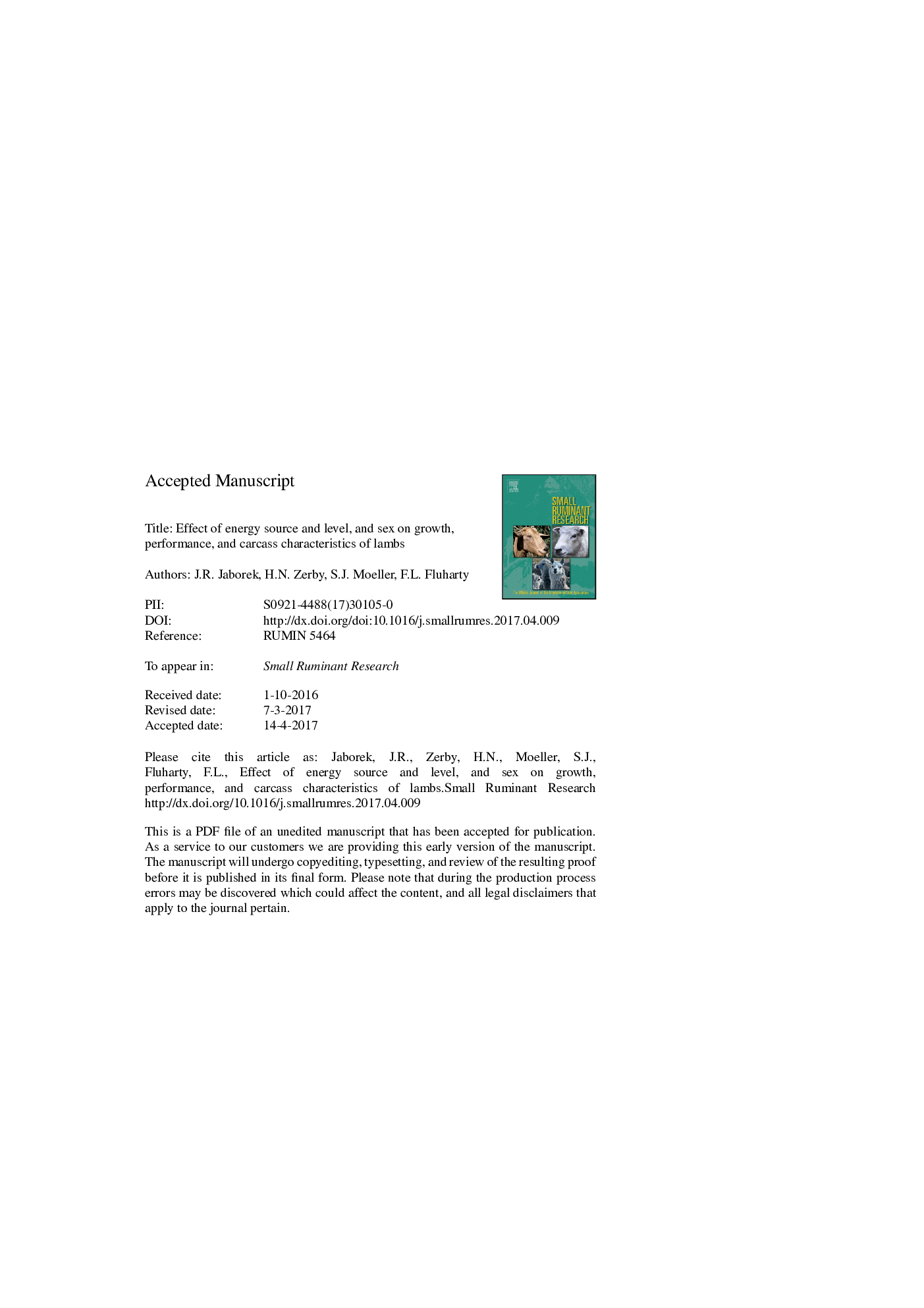| کد مقاله | کد نشریه | سال انتشار | مقاله انگلیسی | نسخه تمام متن |
|---|---|---|---|---|
| 5544184 | 1554341 | 2017 | 23 صفحه PDF | دانلود رایگان |
عنوان انگلیسی مقاله ISI
Effect of energy source and level, and sex on growth, performance, and carcass characteristics of lambs
ترجمه فارسی عنوان
تأثیر منبع انرژی و سطح و جنس بر رشد، عملکرد و خصوصیات لاشه بره ها
دانلود مقاله + سفارش ترجمه
دانلود مقاله ISI انگلیسی
رایگان برای ایرانیان
موضوعات مرتبط
علوم زیستی و بیوفناوری
علوم کشاورزی و بیولوژیک
علوم دامی و جانورشناسی
چکیده انگلیسی
The objective of the study was to compare ad libitum or restricted access of whole shelled corn (WSC) versus ad libitum alfalfa pellets, and sex of the lamb, on lamb growth and performance. Ewe (n = 48) and wether (n = 48) lambs were blocked by sex and stratified by initial weight to pen. The three diets offered were ad libitum access of a WSC diet, 85% access of ad libitum WSC diet, or an ad libitum access of an alfalfa pellet diet. There were four lambs per pen, and eight replicate pens per dietary treatment. Ewe and wether lambs were removed from the study when pens reached an average weight of 59.0 and 63.5 kg, respectively. Average daily gain (ADG) of lambs offered the ad libitum WSC diet was greater (P < 0.05) than lambs offered the restricted WSC and alfalfa pellet diets, which resulted in fewer (P < 0.01) days on feed for lambs offered ad libitum WSC. Lambs offered alfalfa pellets had a greater (P < 0.01) daily dry matter intake (DMI) than lambs offered the WSC diets. Wether lambs had greater (P < 0.01) daily DMI when compared with ewe lambs. Gain to feed ratio was greatest (P < 0.01) for lambs offered ad libitum access to WSC, followed by lambs offered restricted WSC, and lambs offered the alfalfa pellet diet. The cost of whole shelled corn was $0.15/kg, the cost of alfalfa pellets was $0.60/kg, and the cost of supplements was $0.51/kg on an as-fed basis. The resulting feed cost of gain was greatest (P < 0.01) for lambs offered alfalfa pellets, followed by lambs offered restricted WSC, and lastly lambs offered ad libitum WSC. Lambs offered the WSC diets produced a greater hot carcass weight (HCW; P < 0.01) and greater (P < 0.01) dressing percent when compared with lambs offered alfalfa pellets. Lambs consuming ad libitum WSC had a greater amount (P < 0.05) of kidney fat when compared with lambs consuming a restricted diet of WSC or ad libitum access to alfalfa pellets. Lambs consuming either of the WSC diets produced a greater (P < 0.05) amount of visceral fat when compared with lambs offered alfalfa pellets. Lambs offered alfalfa pellets had greater tissue weight of the reticulum (P < 0.05), omasum (P < 0.01), and total digestive tract (P < 0.05), consistent with the lower dressing percentage observed. Lambs offered WSC had greater (P < 0.05) backfat and body wall thicknesses, loin marbling scores, and yield grades (P < 0.01) when compared with lambs offered alfalfa pellets. Wether lambs had a greater (P < 0.05) final BW and HCW when compared with ewe lambs. Overall, lambs offered ad libitum WSC grew more efficiently at a lower cost of gain while producing carcasses with greater amounts of fat, whereas lambs offered alfalfa pellets had a lower dressing percentage and a greater total digestive tract weight.
ناشر
Database: Elsevier - ScienceDirect (ساینس دایرکت)
Journal: Small Ruminant Research - Volume 151, June 2017, Pages 117-123
Journal: Small Ruminant Research - Volume 151, June 2017, Pages 117-123
نویسندگان
J.R. Jaborek, H.N. Zerby, S.J. Moeller, F.L. Fluharty,
